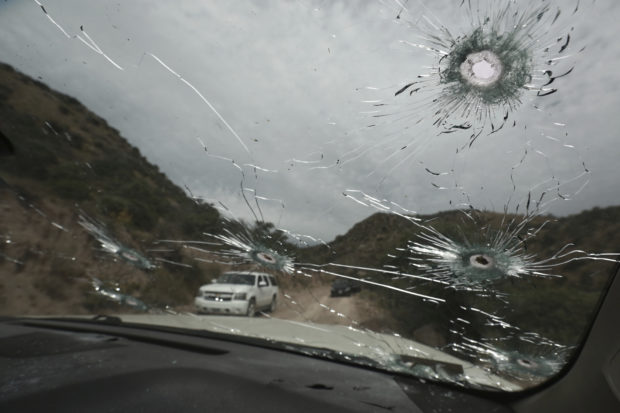COLONIA LEBARON, Mexico — When drug cartel gunmen opened fire on American women and children in northern Mexico, the Mexican Army, the National Guard and Sonora state police were not there to protect them. It took them about eight hours just to arrive.

Bullet-riddled vehicles that members of the extended LeBaron family were traveling in sit parked on a dirt road near Bavispe, at the Sonora-Chihuahua state border, Mexico, Wednesday, Nov. 6, 2019. Three women and six of their children, related to the extended LeBaron family, were gunned down in an attack while traveling here Monday. (AP Photo/Christian Chavez)
To villagers and others, the bloodshed seemed to demonstrate once more that the government has lost control over vast areas of the country to the drug traffickers.
“The country is suffering very much from violence,” said William Stubbs, a pecan and alfalfa farmer who serves on a community security committee in the American-dominated hamlet of Colonia LeBaron. “You see it all over. And it ain’t getting better. It’s getting worse.”
The lack of law enforcement in rural areas like the northern states of Chihuahua and Sonora once led the dual U.S.-Mexican residents of places like Colonia LeBaron to form their own civilian defense patrols.
Stubbs said that after the 2009 killing of anti-crime activist Benjamin LeBaron, residents positioned themselves each night for two years with high-powered binoculars to keep watch from the large “L” for “LeBaron” that stands on a hillside above the town.
Since then, he said, the cartels have left Le Baron and the town of Galeana a few kilometers to the north alone. But he said they have watched the cartels get stronger in the past two decades, with nearby communities in the mountains suffering from violence and extortion.
This week, he said, the military told him that the town of Zaragoza had been about 50% abandoned.
Army chief of staff Gen. Homero Mendoza said Wednesday that Monday’s ambush — which killed three American mothers and six of their children — started at 9:40 a.m., but the nearest army units were in the border city of Agua Prieta, about 100 miles (160 kilometers) and 3½ hours away.
Soldiers didn’t start out for the scene until 2:30 p.m. and didn’t arrive until 6:15 p.m. — even while five surviving children lay hiding in the mountains with bullet wounds.
“There are areas where the government’s control is very fragile,” said Mexican security analyst Alejandro Hope.
President Andres Manuel Lopez Obrador created the militarized National Guard after he took office last December to help law enforcement, but its 70,000 troops have to cover a vast territory.
“The government’s main policy tool, the National Guard, is not where it should be,” Hope said, noting that Sonora and Chihuahua states, with over 160,000 square miles (420,000 square kilometers) between them, have only about 4,100 National Guard officers stationed there, or about one for every 40 square miles. “It should be in the mountains, and it’s not there.”
Questions have also arisen over whether the army can do its job even when it is present. On Oct. 17, soldiers were forced to release the captured son of drug lord Joaquin “El Chapo” Guzman to avoid further bloodshed after Sinaloa cartel gunmen counterattacked in greater numbers in the city of Culiacan.
Colonia Le Baron is a place where the U.S. influence is evident everywhere you look: pickup trucks with license plates from California, Idaho, Colorado, Washington, and English-speaking customers eating hamburgers at Ray’s Restaurant, Coffee & Grill. Many of the dual citizens were born here, and their families have been here for decades.
Stubbs predicted that some people will move their families to the United States out of fear but will ultimately come back, as happened after the 2009 killing. He seemed dubious about López Obrador’s “hugs, not bullets” security strategy of trying to solve underlying social problems instead of battling the drug cartels with military force.
“I’m really shocked actually of his way of thinking, and it ain’t going to solve the problems,” he said.
Residents know they can’t fight the cartels on their own.
“We’re not experts in military and war and weapons,” Stubbs said. “We’re farmers, and we have great families and big families, and we definitely want our families to be peaceful.”
Mexican officials said the attackers may have mistaken the group’s large SUVs for those of a rival gang. The Juarez drug cartel and its armed wing, known as “La Linea,” or “The Line,” are fighting a vicious turf war against a faction of the Sinaloa cartel known as the “Salazar.”
“Those who attacked the occupants (of the vehicles), they let the children go, so that we can deduce that it was not a targeted attack” against the families, Mendoza said.
Most of the victims lived about 70 miles (110 kilometers) south of Douglas, Arizona, in the hamlet La Mora, founded decades ago by an offshoot of The Church of Jesus Christ of Latter-day Saints. Many La Mora residents call themselves Mormons but are not affiliated with the church. Many are related to the extended LeBaron family.
The killers were believed to be from La Linea, whose gunmen had entered Sinaloa cartel territory the previous day and had set up an armed outpost on a hilltop near La Mora and an ambush farther up the road. The Juarez cartel apparently wanted to prevent Sinaloa gunmen from entering their territory in Chihuahua state.
It was this force that the American mothers drove into.